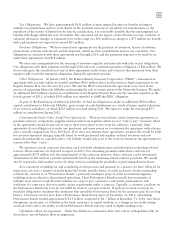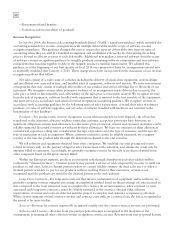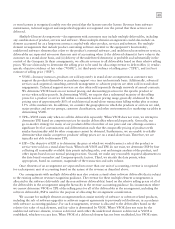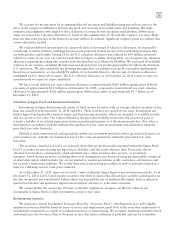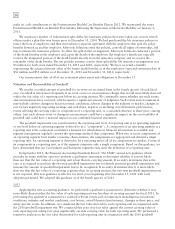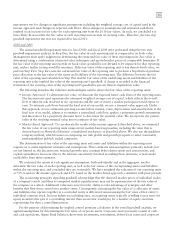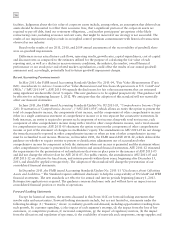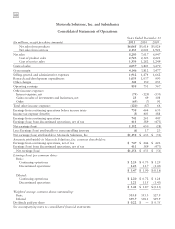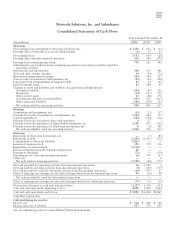Motorola 2011 Annual Report Download - page 59
Download and view the complete annual report
Please find page 59 of the 2011 Motorola annual report below. You can navigate through the pages in the report by either clicking on the pages listed below, or by using the keyword search tool below to find specific information within the annual report.
53
principle underlying the required attribution approach is that employees render service over their service lives on a
relatively consistent basis and, therefore, the income statement effects of pension benefits or postretirement health
care benefits are earned in, and should be expensed in, the same pattern.
There are various assumptions used in calculating the net periodic benefit expense and related benefit
obligations. One of these assumptions is the expected long-term rate of return on plan assets. The required use of
the expected long-term rate of return on plan assets may result in recognized pension income that is greater or less
than the actual returns of those plan assets in any given year. Over time, however, the expected long-term returns
are designed to approximate the actual long-term returns and therefore result in a pattern of income and expense
recognition that more closely matches the pattern of the services provided by the employees. Differences between
actual and expected returns are recognized in the net periodic pension calculation over five years.
We use long-term historical actual return experience with consideration of the expected investment mix of the plans’
assets, as well as future estimates of long-term investment returns, to develop our expected rate of return assumption used
in calculating the net periodic pension cost and the net retirement healthcare expense. Our investment return assumption
for the Regular Pension Plan and Postretirement Healthcare Benefits Plan was 8.25% in both 2011 and 2010. The
investment return assumption for the Officers’ Plan was 6% in both 2011 and 2010. At December 31, 2011, the Regular
Pension Plan and the Postretirement Health Care Benefits Plan investment portfolios were predominantly equity
investments and the Officers’ Plan investment portfolio was predominantly fixed-income securities.
A second key assumption is the discount rate. The discount rate assumptions used for pension benefits and
postretirement health care benefits accounting reflects, at December 31 of each year, the prevailing market rates for
high-quality, fixed-income debt instruments that, if the obligation was settled at the measurement date, would
provide the necessary future cash flows to pay the benefit obligation when due. Our discount rates for measuring
our U.S. pension obligations were 5.10% and 5.75% at December 2011 and 2010, respectively. Our discount rates
for measuring the Postretirement Health Care Benefits Plan obligation were 4.75% and 5.25% at December 31,
2011 and 2010, respectively.
A final set of assumptions involves the cost drivers of the underlying benefits. The rate of compensation
increase is a key assumption used in the actuarial model for pension accounting and is determined by us based upon
our long-term plans for such increases. Our 2011 and 2010 rate for future compensation increase for the Regular
Pension Plan and Officers’ Plan was 0%, as the salaries to be utilized for calculation of benefits under these plans
have been frozen. For the Postretirement Health Care Benefits Plan, we reviews external data and our own historical
trends for health care costs to determine the health care cost trend rates. The health care cost trend rate used to
determine the December 31, 2011 accumulated postretirement benefit obligation is 7.25% for 2012, remaining flat
at 7.25% through 2015, then grading down to a rate of 5% in 2019. The health care cost trend rate used to
determine the December 31, 2010 accumulated postretirement benefit obligation was 7.25% for 2011, remaining
flat at 7.25% through 2013, then grading down to a rate of 5% in 2016.
For the year ended December 31, 2011, we recognized net periodic pension expense of $151 million related to
our U.S. pension plans. For the year ended December 31, 2010, we recognized net periodic pension expense for our
U.S. pension plans of $119 million. Cash contributions of $489 million were made to the U.S. pension plans during
2011. In January 2011, the Pension Benefit Guaranty Corporation (“PBGC”) announced an agreement with
Motorola Solutions under which we would contribute $100 million above and beyond our legal requirement to our
Regular Pension Plan over the next five years. We and the PBGC entered into the agreement as we were in the
process of separating Motorola Mobility and pursuing the sale of certain assets of our Networks business. We made
an additional $250 million of pension contributions to the Regular Pension Plan over the amounts required, in the
fourth quarter of 2011, of which $100 million was intended to fulfill the PBGC obligation. Also in January 2011,
we elected the available optional pension contribution relief which reduced our required 2011 Regular Pension Plan
contribution from approximately $265 million to approximately $235 million. In December 2011, we elected the
available optional pension contribution relief which reduced our expected 2012 regular pension contribution from
approximately $408 million to approximately $340 million. We expect to make cash contributions of
approximately $340 million to our U.S. pension plans and approximately $30 million to our non-U.S. pension plans
during 2012. We maintained all of the U.S. pension liabilities and the majority of the non-U.S. pension liabilities
following the Separation of Motorola Mobility on January 4, 2011 and following the sale of certain assets and
liabilities of the Networks business to NSN.
We recognized net postretirement health care expense of $20 million and $18 million for the years ended
December 31, 2011 and 2010, respectively. No cash contributions were made to this plan in 2011. We expect to




